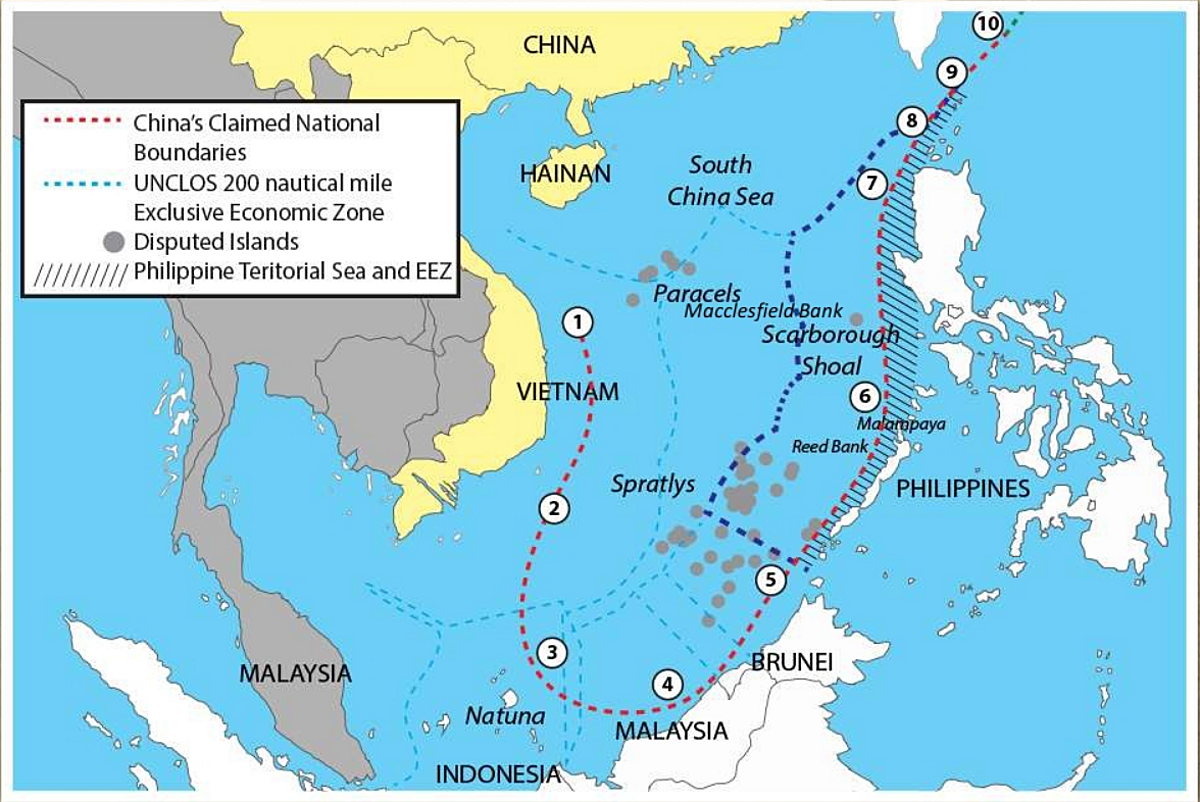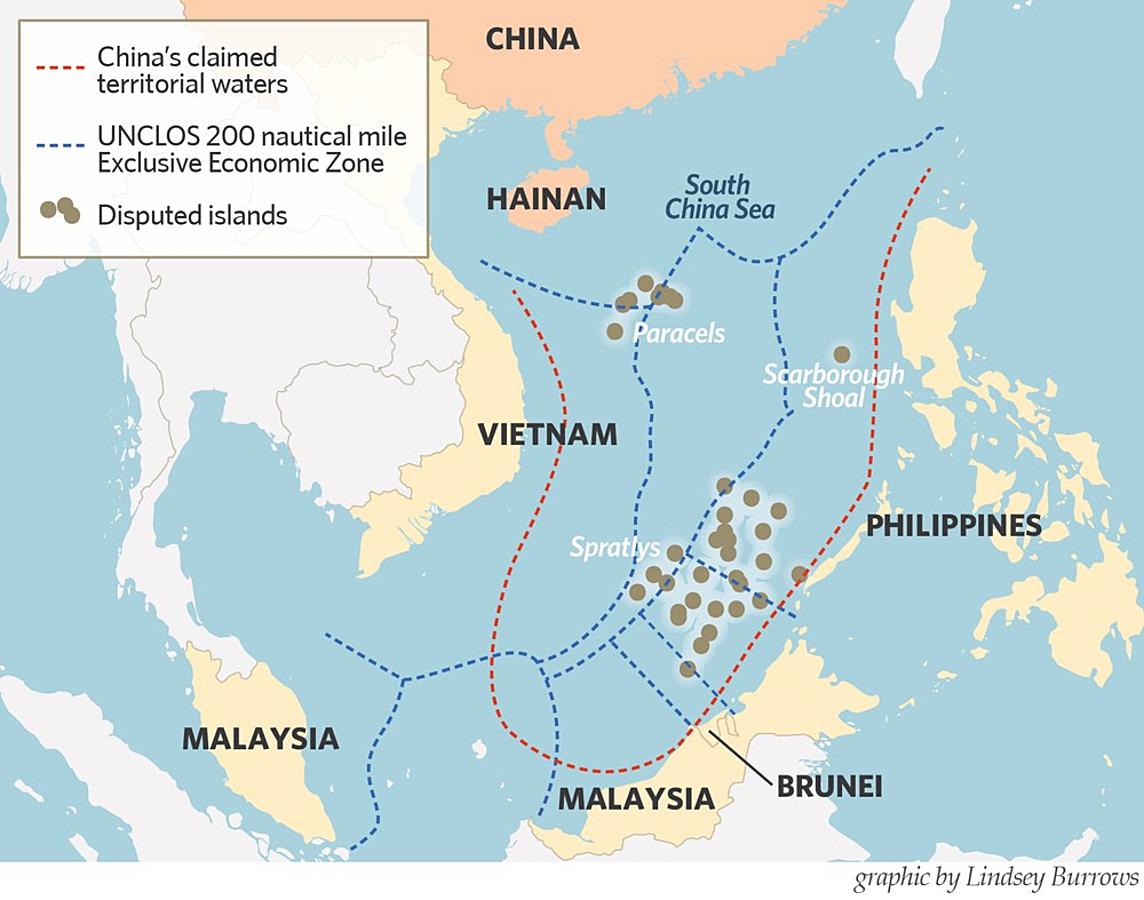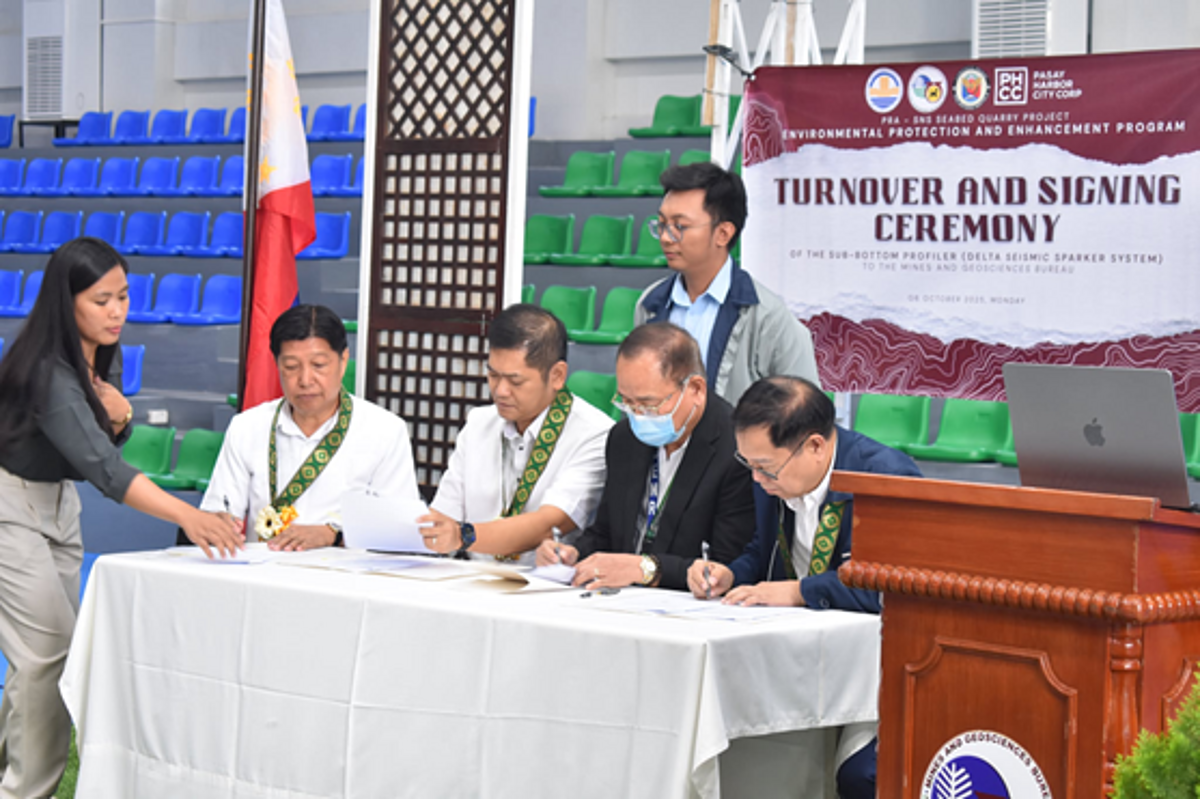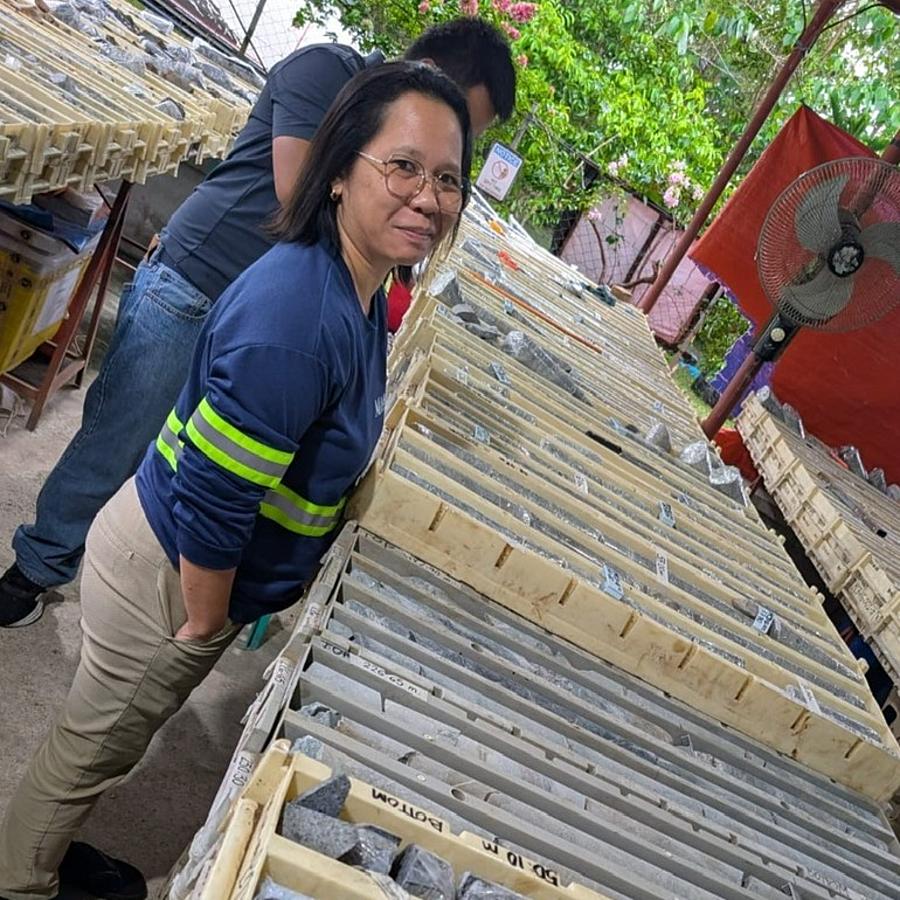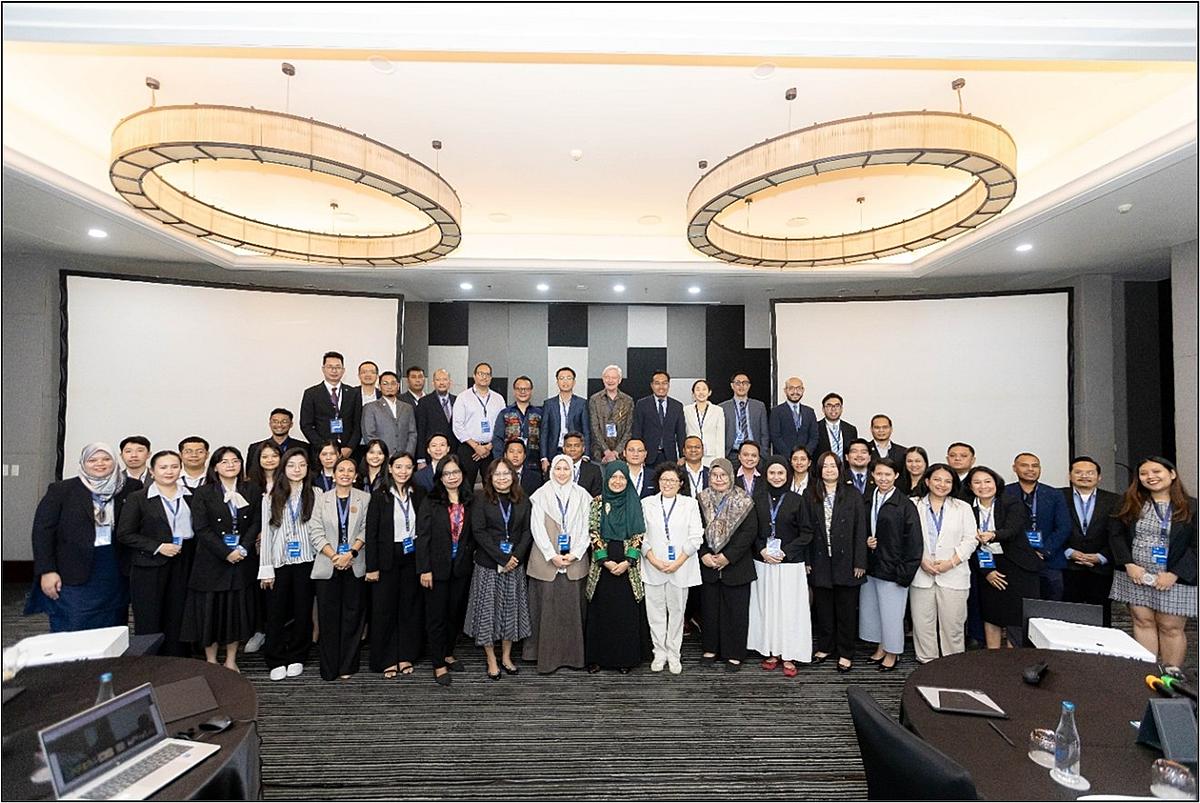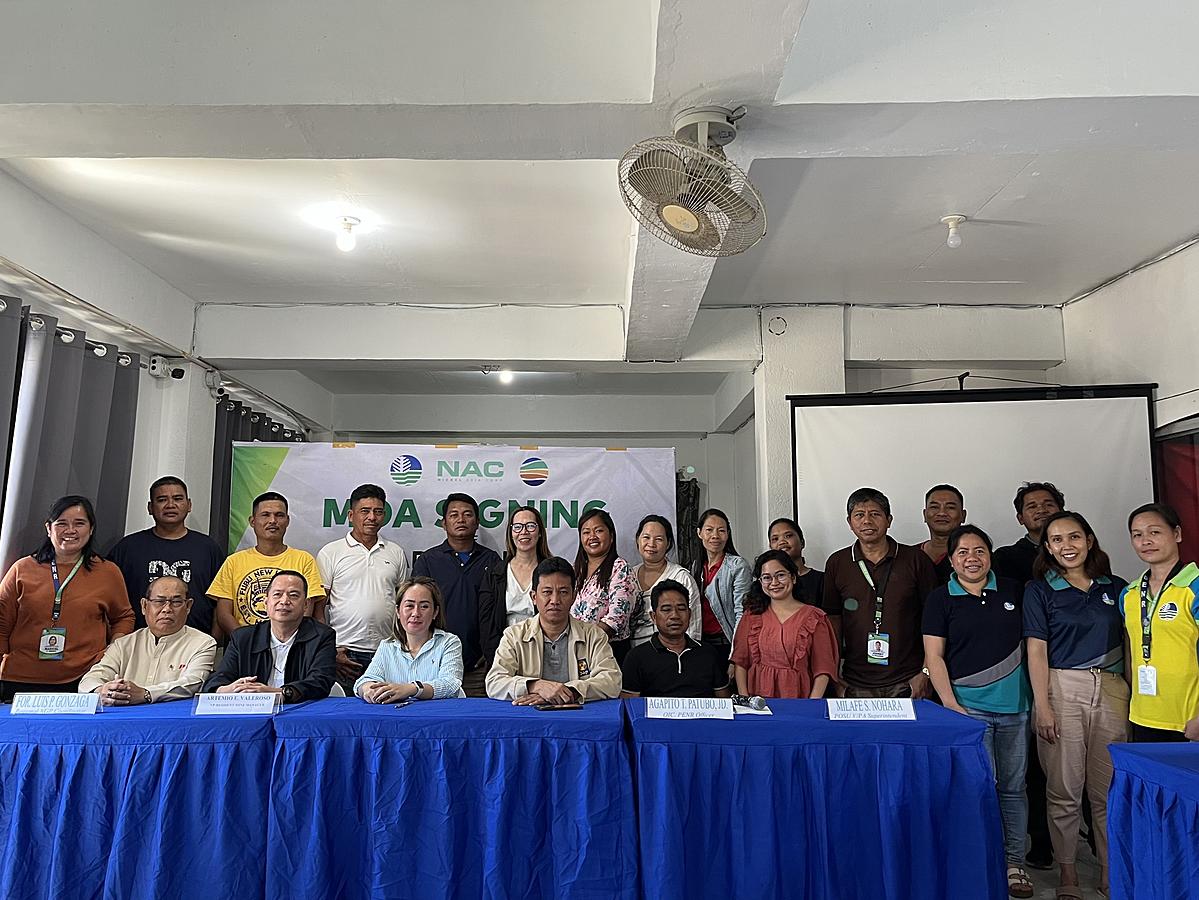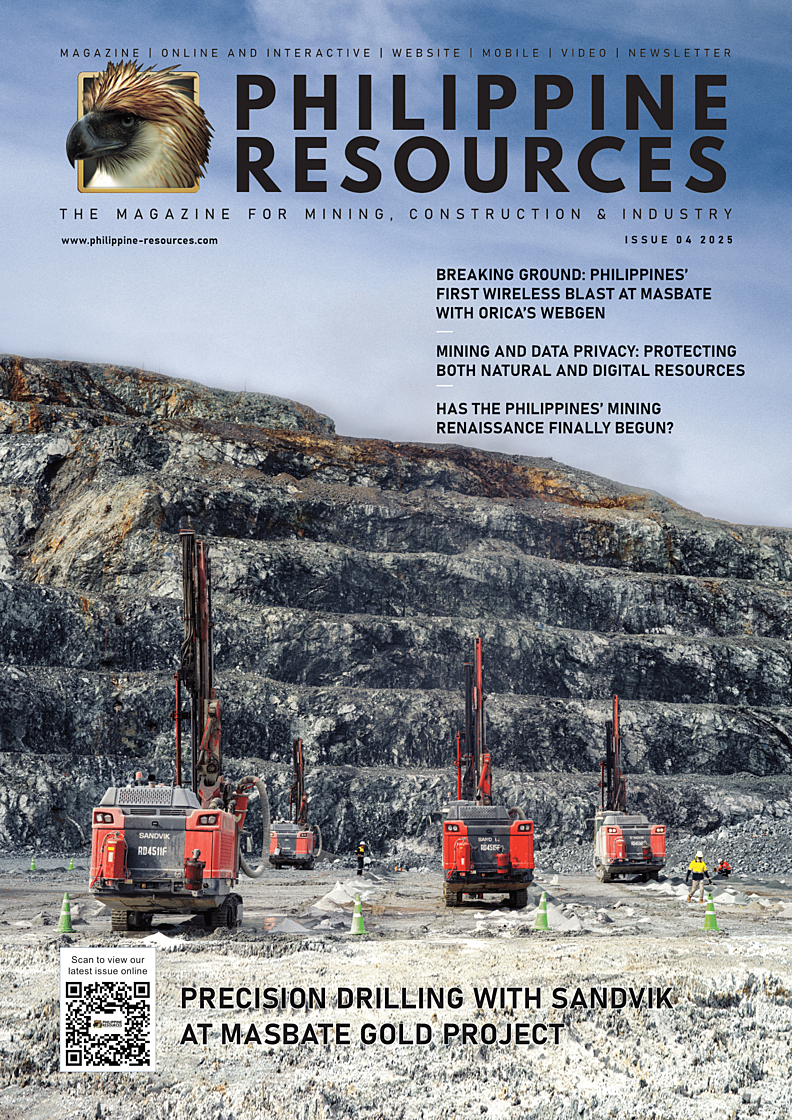[Photo credit: Justice Antonio T. Carpio. “The South China Sea West Philippine Sea Dispute” - https://www.slideshare.net/SamGalope/lecture-the-south-china-sea-west-philippine-dispute-justice-antonio-t-carpio-philippine-social-science-center]
On 7 May 2009, China submitted the Nine-dashed Lines Map to the United Nations. Their map gobbles up large areas of the Exclusive Economic Zone (EEZ) and Extended Continental Shelf (ECS) of the Philippines, Vietnam, Malaysia, Brunei and Indonesia. China’s Nine-Dashed Lines Map shows that China is claiming 85.7% of the entire South China Sea. Their claim covers 3 million square kilometers out of the 3.5 million square kilometers surface area of the South China Sea. [1] This is the root cause of the South China Sea dispute, because China did not provide a legal basis for the dashes. The dashes also had no fixed coordinates. With that, the Philippines, Malaysia, Vietnam and Indonesia protested against China’s claim. This story is more than about defending our territorial or maritime rights. It is also of geological significance and fighting for our own natural resources.
In January 2013, the Philippines formally initiated arbitration proceedings against the PRC’s claim on the territories within the “nine-dash line” that include the Scarborough Shoal. [2]
Justice Antonio T. Carpio, Senior Associate Justice of Republic of the Philippines Supreme Court, defended the Philippines’ right of ownership of the little islands within our territory to the international Arbitral Tribunal. His strategy in explaining our claim was simple – pointing out our legal rights through legitimate historical records. In his presentation “The South China Sea West Philippine Sea Dispute”, he enumerates several important facts about our territory.
To begin with, what is the significance of the South China Sea to the world? There are US$5.3 trillion of ship-borne goods that travel through the South China Sea annually. This is almost one-half of the world’s shipborne trade in tonnage. A great percentage of the petroleum imports of South Korea, Japan, Taiwan, and China pass through the South China Sea. The annual global fish catch from South China Sea is worth US$21.8 billion. Additionally, 2 billion people live in the 10 countries bordering the South China Sea where hundreds of millions of people depend on fish there for their protein. More importantly, maritime area that are close to the coast of the countries bordering the South China Sea are rich in oil and gas resources.
South China Sea is also rich in methane hydrate which is a potential source of energy. [3]
Over 250 small islands, atolls, shoals, reefs, cays and sandbars are located at the South China Sea. These small land area have no inhabitants. The features are grouped into three archipelagos namely, Macclesfield Bank, Scarborough Shoal, Pratas Islands, Paracel Islands and Spratly Island. [2]
How does the Nine-dashed Line Map affect the Philippines? The Philippines loses about 80% of its EEZ facing the West Philippine Sea. This includes the entire Reed Bank and part of the Malampaya gas field. This loss covers 381,000 square kilometers of maritime space and 100% of the Philippines’ ECS which covers an estimate of over 150,000 square kilometers of maritime space.
In 2012, China seized Scarborough Shoal (Panatag) from the Philippines. It is a small ring of reefs that is located about 230 km from the Philippines, but 650 km from the nearest major Chinese land mass (southern island of Hainan province). Scarborough Shoal is rich in marine life where fishermen from the Philippines, China and Vietnam have been fishing for several years. It is in the Philippines EEZ. [4]
Martin Luther King, Jr. once said, “Learn a little about your past, and you may end up with a pretty nice future”. Looking back in our history was indeed the winning strategy on how the west was won in this dispute. Here are some of the historical proofs and legal basis presented by Justice Antonio T. Caprio before the Tribunal.
1. Official and unofficial maps of China from 1136 during the Song Dynasty until the end of the Qing Dynasty in 1912 show that the southernmost territory of China has always been Hainan Island, and not the areas of the Nine-Dashed Lines. On the other hand, there are various official and unofficial maps of the Philippines from 1636 until 1933 that consistently illustrate that Scarborough Shoal has always been part of the Philippines. Centuries ago, the name of Scarborough Shoal was “Panacot” according to the Murillo Velarde Map in 1734. This was published in Manila while the Philippines was still a colony of Spain. [5]
2. The Franciscans arrived in the Philippines in 1578. In 1695, the Coronelli Map of Southeast Asia (entitled Isloe dell’ Indie) shows the Spratlys as part of the Philippines. The map was illustrated by the Franciscan monk, Venetian Vincenzo Coronelli. The map was published in Venice in 1695. Coronellie is well-known for his accurate atlases and globes, and as the Father General of the Franciscan Order.
3. In 1899, the map “Islas Filipinas, Mapa General Observatorio de Manila” was published in Washington, D.C. by the U.S. Coast of Geodetic Survey. This old map resembles the modern Philippine map that we use today.
4. In 1898, when the Philippine Revolution was about to end in victory to end 300 years of Spanish rule, Spain secretly sold the Philippines to the United State of America under what is known as the 1898 Treaty of Paris between Spain and the United States. This agreement did not include the little islands surrounding the main islands of the country, thus another treaty was made called the 1900 Treaty of Washington.
5. The Treaty of Washington entails that Spain had given to the United States “all title and claim of title, which (Spain) may have had at the time of the conclusion of the Treaty of Peace of Paris, to any and all islands belonging to the Philippine Archipelago, lying outside the lines” of the Treaty of Paris. Therefore this agreement clarifies that Spain ceded Scarborough Shoal to the United States under the 1900 Treaty of Washington (or the Treaty between Spain and the United States for Cession of Outlying Islands of the Philippines, signed November 7, 1900).
6. Additionally, Secretary Cordell Hull of the U.S. State Department mentioned in his Memorandum of July 27, 1938 to Harry Woodring, Secretary of War: “In the absence of evidence of a superior claim to Scarborough Shoal by any other government, the Department of State would interpose no objection to the proposal of the Commonwealth Government to study the possibilities of the shoal as an aid to air and ocean navigation.”
Finally, on 4 July 1946, the Treaty of Manila has been signed granting the Philippines full independence from the United States of America.
7. Scarborough Shoal was also used by the United States and the Philippine military as an impact range for their warships and warplanes from 1960s – 1980s. The International Maritime Organization of the United Nations was notified of such activities. During those years, there were no protests from any country about these activities.
In conclusion, “The Philippines today is engaged in a historic battle to defend over 531,000 square kilometers of its maritime space (EEZ and ECS) in the West Philippine Sea, an area larger than the total land area of the Philippines of 300,000 square kilometers. This huge maritime space is part of Philippine national territory since the Constitution defines the ‘national territory’ to include ’the seabed, the subsoil, and other submarine areas’ over which the Philippines has ‘sovereignty or jurisdiction’. Under UNCLOS, the Philippines has ‘jurisdiction’ over this huge maritime space. Can the Philippines prevent China from gobbling up this huge maritime space? All citizens of the Philippines - both government personnel and private individuals – have a solemn duty to prevent the loss of this huge maritime space. It is a duty we owe to ourselves, and to future generations of Filipinos. The Historic Battle for the West Philippine Sea.” [5] (From the presentation of Justice Antonio T. Carpio)
On 12 July 2016, the Permanent Court of Arbitration (PCA) tribunal in Netherlands agreed unanimously with the Philippines. They concluded that there is no evidence and "no legal basis for China to claim historic rights" over the area within the nine-dash line. The tribunal also judged that the PRC had caused "severe harm to the coral reef environment" [6] and had violated the Philippines’ sovereign rights in its EEZ by interfering with Philippine fishing and petroleum exploration (such as restricting the Filipino fishermen at Scarborough Shoal). PRC rejected this ruling. Their president Xi Jinping said that, "China's territorial sovereignty and marine rights in the South China Sea will not be affected by the so-called Philippines South China Sea ruling in any way", nevertheless the PRC would still be "committed to resolving disputes" with its neighbours. China afterwards sent more warships in the Scarborough Shoal. [7][8]
Disclaimer: Regarding “The South China Sea West Philippine Sea Dispute” by Justice Antonio T. Caprio – The views expressed in the presentation are the personal opinion of the author and do not necessarily represent the position of the Philippine Government.
References:
[1] “South China Sea Arbitral Award” - https://www.slideshare.net/SamGalope/south-china-sea-arbitral-award
[2] South China Sea - https://en.wikipedia.org/wiki/South_China_Sea
Scarborough Shoal - https://en.wikipedia.org/wiki/Scarborough_Shoal
[3] Justice Antonio T. Carpio. “The South China Sea West Philippine Sea Dispute” - https://www.slideshare.net/SamGalope/lecture-the-south-china-sea-west-philippine-dispute-justice-antonio-t-carpio-philippine-social-science-center
[4] “5 facts on Scarborough Shoal” (8 Feb. 2017) by Agence France-Presse and ABS-CBN News - https://news.abs-cbn.com/news/02/07/17/5-facts-on-scarborough-shoal
[5] https://www.slideshare.net/7philippines/the-south-china-sea-west-philippine-sea-dispute
[6] Perez, Jane (12 July 2016). "Beijing's South China Sea Claims Rejected by Hague Tribunal". The New York Times.
[7] Tom Phillips, Oliver Holmes, Owen Bowcott (12 July 2016). "Beijing rejects tribunal's ruling in South China Sea case". The Guardian.
[8] "South China Sea: Tribunal backs case against China brought by Philippines". BBC. 12 July 2016.

